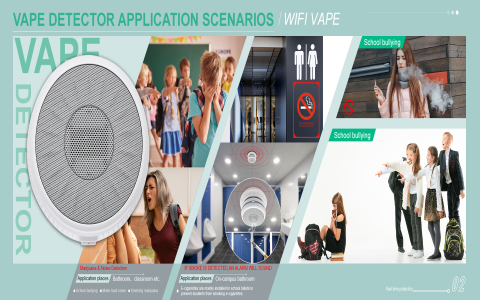Understanding Electronic Cigarette Detectors
Electronic cigarette detectors, also known as vape detectors, are specialized sensing devices designed to identify the presence of aerosols and particulate matter produced by e-cigarettes, vapes, and similar nicotine delivery systems. Their primary function is to aid in the enforcement of no-vaping policies in designated smoke-free or vape-free environments.
Detection Technologies
Most commercially available electronic cigarette detectors operate on principles similar to advanced smoke detectors, focusing on particulate matter. Key technologies include:

- Optical Particle Sensing: These sensors use light scattering (nephelometry). An internal light source (often an LED or laser diode) illuminates the air. When vape aerosol particles pass through the light beam, they scatter the light. A photodetector measures the amount of scattered light, which correlates to the concentration of particles.
- Advanced Algorithms: To minimize false alarms from sources like dust, steam, or aerosols from cleaning products, sophisticated algorithms analyze the size, density, and pattern of detected particles. Some detectors look for specific particle size distributions characteristic of e-cigarette aerosols.
- Chemical Sensing (Less Common for Real-Time): While less prevalent for instant detection in situ, some advanced systems or laboratory analyses might utilize chemical sensors to detect specific volatile organic compounds (VOCs) like propylene glycol (PG), vegetable glycerin (VG), or specific flavorings present in e-liquids. However, real-time detectors primarily rely on particulate detection.
Key Features and Considerations
When selecting or evaluating electronic cigarette detectors, consider the following features:
- Sensitivity and Adjustability: The ability to detect low concentrations of vape aerosol and adjust sensitivity levels to suit different environments.
- Coverage Area: The effective range the detector can monitor, typically specified in square feet or cubic feet.
- Alert Mechanisms: Options include audible alarms, visual LED indicators, silent notifications (e.g., email, SMS, app alerts to designated personnel), and integration with building management or security systems.
- False Alarm Reduction: Advanced discrimination technology to distinguish vape aerosol from other airborne particulates.
- Power Source: Options include battery-powered (with considerations for battery life), Power over Ethernet (PoE), or hardwired AC/DC power.
- Tamper Resistance: Features to prevent unauthorized disabling or damage to the unit.
- Data Logging and Reporting: Capability to log detection events with timestamps for record-keeping and analysis.
- Connectivity: Wi-Fi, Ethernet, or cellular connectivity for remote monitoring, management, and alerts.
- Discreet Design: Aesthetics that allow the detector to blend into its environment, especially in public spaces.
Applications
Electronic cigarette detectors are increasingly deployed in various settings to maintain vape-free environments, including:
- Educational Institutions: Schools (K-12), colleges, and universities, particularly in restrooms, locker rooms, and dormitories.
- Healthcare Facilities: Hospitals, clinics, and long-term care facilities.
- Workplaces: Offices, manufacturing plants, and corporate campuses.
- Hospitality: Hotels (guest rooms, common areas), restaurants, and event venues.
- Public Transportation: Buses, trains, and transportation hubs.
- Correctional Facilities.
- Retail Environments.
Benefits of Deployment
The implementation of electronic cigarette detectors offers several advantages:
- Deterrence: The visible presence of detectors can discourage vaping in prohibited areas.
- Policy Enforcement: Provides a reliable method for detecting violations of no-vaping policies.
- Improved Air Quality: Helps maintain healthier indoor environments by reducing exposure to secondhand aerosol.
- Protection of Vulnerable Populations: Safeguards individuals, especially children and those with respiratory conditions, from vape aerosol exposure.
- Support for Cessation Efforts: Complements efforts to reduce nicotine use among students or employees.










